Genre: Platform Developer: Red Publisher: MediaQuest Players: 1 Released: 1998
I’ve been a fan of Red’s Tempo ever since it was first released on the 32X back in 1995, despite its generic gameplay and how quickly it blended into the mascot platformer background of the era. Indeed, the incredible colors and wacky gameplay really often tempted me to buy the little mushroom, but alas, I was one of the many who held onto his dollars for the upcoming Saturn. In a certain way, I still regret my decision to not purchase Tempo at launch. Maybe it’s that feeling that I didn’t do my part to support games like it – those neat 2D platformers that we now so desperately wish would emigrate from the Nintendo DS back to consoles. My little grain of sand might not have made much of a difference, but it sure would have made me feel better each time I boot the darn game up.
As fate would have it, the same situation would arise with the Saturn sequel, Super Tempo This time, however, it wasn’t my fault. Sega kept the game in Japan, and I was instead importing titles like Thunder Force V and Grandia to buy it. I figured that it would be given the same low-selling fate as its predecessor, and I could soon pick it up for a bargain price. Boy, was I wrong. Copies have been going on eBay for well past $300 for some time now, and it was only by luck that I was able to finally play it.
I don’t know why Sega decided not to release Super Tempo in America. Perhaps it was too enthralled with the assured blockbuster status of games like Ghen War. No one can tell. It could have had something to do with Sega’s attitude that new hardware meant a new attitude, far outgrown of the trappings of 16-bits. Perhaps that’s the reason for change in publisher, since Tempo creator Red (Bonk’s Adventure, Sakura Taisen) replaced Sega with MediaQuest. The difference? Nothing, really. Red stuck to its platforming guns, no matter who published the game, and the result is a solid sequel.
Super Tempo may at first seem like more of the same, and in essence it is, but there’s been enough of a change to the gameplay to make it worth playing. The whole television show dynamic has been scrubbed, and Tempo and his friends are now in the service of Major Minor (the pimp game show host of the original). Tasked with several objectives, the duo set off across a plethora of different stages, fighting cute enemies all the way. The basic gameplay remains the same: jump and shoot. However, things have been mixed around a bit, and veteran Tempo players will need a moment or two to get accustomed. No longer does our grasshopper friend flick musical notes at his enemies. Instead, he shoots… bubbles out of his fiddle. Yeah, I know it sounds kind of lame, but the bubbles can incapacitate a foe by encasing him, leaving him completely at one’s mercy. This is very useful, as Tempo can no longer kill foes by jumping on them. Since the bubbles are tossed in a small arc, as opposed to straight forward as before, players will have to position themselves correctly to be able to hit anything. It’s unclear why Red made the change, but I would assume it’s because of the original’s low difficulty.
Tempo can still hover when the jump button is held down, and he still collects notes, but most of the interesting power ups have been removed. Probably the most interesting ones make him and Katy the Butterfly morph into massively muscular heroes, but these are sadly only used in boss fights. In essence, the gameplay is even simpler than it was before, and that’s saying something.
One area where the Saturn’s power is instantly evident over the 32X is in the presentation. The original Tempo was a colorful and sharp-looking game, and its sequel is even better. The expanded color palate makes Tempo’s world almost psychedelic in flavor, and the details really come out. There are lots of massive sprites, especially the bosses, and the levels are filled with all kinds of great backgrounds. In some stages, they’re constantly moving, and all the action and weird elements moving around are actually a good distraction. No one can accuse Super Tempo of having dull and boring worlds.
The audio is just as good. Maintaining the catchy flavor of the first game, the score is much better represented on CD than it was on cartridge, despite the use of Q Sound. The classic Tempo theme plays at the beginning, and each musical theme, while not particularly standing out, does its job very well. There’s nothing as memorable as the yodeling cows, but I can’t really find any major faults with the music.
The levels themselves are a bit tamed this time around. They’re also a lot easier to navigate, even in Japanese. I suppose Red learned its lesson about making stages people can actually get through, as these are pretty straight forward. For variety, Red added some shooter stages for Katy. These are perhaps the weirdest parts of the game, and they’re composed of mostly mini games instead of enemies. Stop nuclear missiles from hitting Earth! Save ants from hammerhead sharks! Blast walls composed of numbers by making them count down to zero with each hit! I think this is the part of the game where most of Red’s stash disappeared.
The bosses are equally odd. Tempo defeats a giant robot frog by beating him in a pose off, and a Little Red Riding Hood imitator tries to run Katy down in front of a skeleton diner. The most “normal” of the bunch is a metallic crab! To me, these crazy creatures are all part of what makes Tempo’s universe so unique and inviting.
Super Tempo is a solid platformer that doesn’t really wow players with its gameplay or presentation. Certainly, it’s not a bonafide classic, the kind one shows friends to convince them that the Saturn rocks. I can’t honestly say that it revolutionizes the platforming genre in any way, shape, or form. No, it’s none of that. Instead, it’s a game that fans of the original will embrace without delay. Casual platforming gamers might be somewhat wary at the beginning about just how weird things are, but they’ll get over it once they play past the first stage. “Hardcore” gamers? They’ve probably already played this one in some form or another.
The sad part of all this is that probably none of those mentioned above will ever actually get to play Super Tempo outside of emulation. The incredibly high price it commands puts it beyond a curious impulse purchase and places it well within “this is the only Saturn game I’m missing” territory. Unfortunate, as it’s worth playing. Hey, at least the original can be had for less than the price of combo meal!

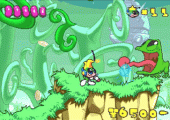
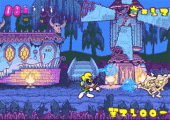
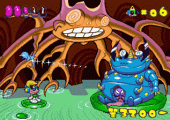
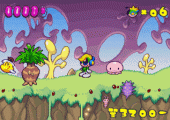
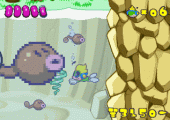
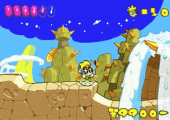
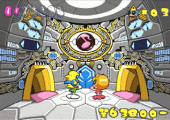
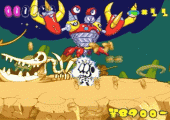
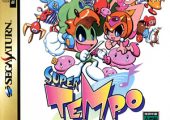
Recent Comments